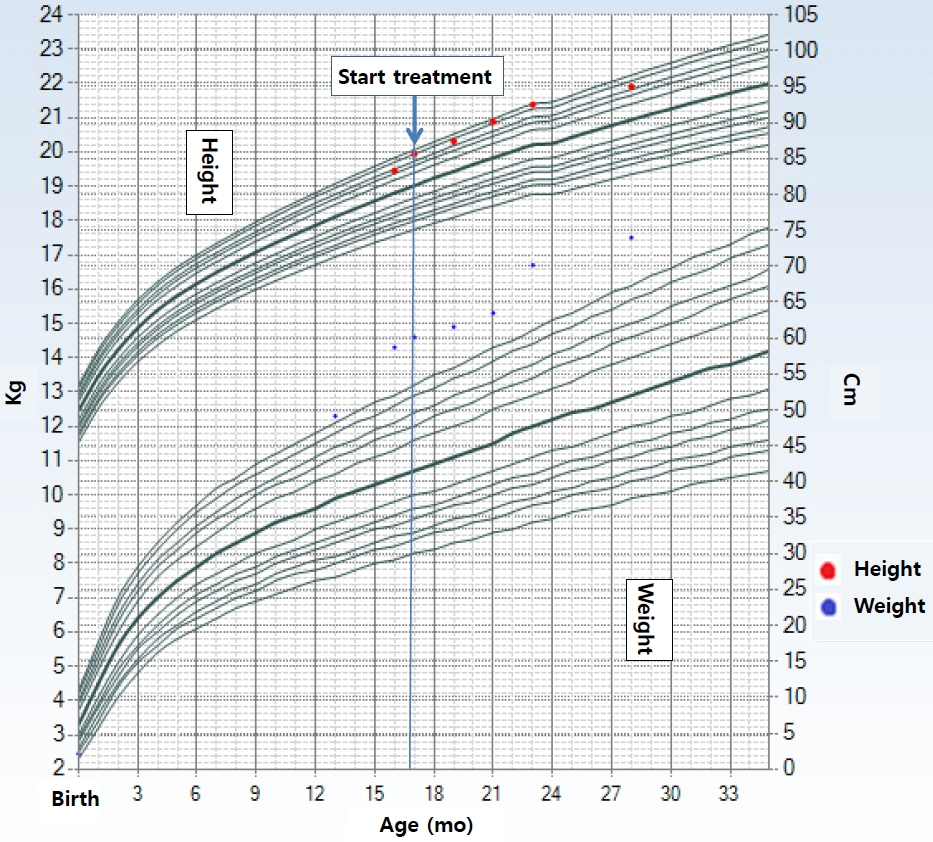Ann Pediatr Endocrinol Metab.
2024 Feb;29(1):60-66. 10.6065/apem.2346042.021.
Familial male-limited precocious puberty due to an activating mutation of the LHCGR: a case report and literature review
- Affiliations
-
- 1Department of Pediatrics, Bundang CHA Medical Center, CHA University, Seongnam, Korea
- KMID: 2553019
- DOI: http://doi.org/10.6065/apem.2346042.021
Abstract
- Familial male-limited precocious puberty (FMPP) is a rare form of gonadotropin-independent precocious puberty that is caused by an activating mutation of the LHCGR gene. Herein, we report a case of FMPP with a mutation of the LHCGR gene in a Korean boy with familial history of precocious puberty through 3 generations. A 16-month-old boy presented with signs of precocious puberty, including pubic hair, acne, and increased growth velocity. The patient's grandfather and father had a history of precocious puberty and profound short stature. On physical examination, the patient had prepubertal testes with pubic hair development appropriate for Tanner stage II. The stretched penile length was 7 cm (>2 standard deviation score), and observed bone age was that of a 4-year-old boy. Laboratory findings showed high serum testosterone (5.74 ng/mL [appropriate for Tanner IV–V]; normal range, <0.05 ng/mL) with suppressed luteinizing hormone (<0.07 mIU/mL) and normal serum level of follicular stimulating hormone (0.56 mIU/mL; normal range, 0.38–1.11 mIU/mL). Genetic testing revealed a pathogenic variant of LHCGR (c.1730 C>T (p.Thr577Ileu)), confirming FMPP. Bicalutamide and anastrozole were administered, and pubertal progression was sufficiently suppressed without any specific side effects. To our knowledge, this is the first case of genetically confirmed FMPP in Korea.
Figure
Reference
-
References
1. Schedewie H, Reiter E, Beitins I, Seyed S, Wooten V, Jimenez J, et al. Testicular Leydig cell hyperplasia as a cause of familial sexual precocity. J Clin Endocrinol Metab. 1981; 52:271–8.2. Shenker A, Laue L, Kosugi S, Merendino JJ, Minegishi T, Cutler GB. A constitutively activating mutation of the luteinizing hormone receptor in familial male precocious puberty. Nature. 1993; 365:652–4.3. Schoelwer M, Eugster EA. Treatment of peripheral precocious puberty. Endocr Dev. 2016; 29:230–9.
Article4. Leschek EW, Flor AC, Bryant JC, Jones JV, Barnes KM, Cutler Jr GB. Effect of antiandrogen, aromatase inhibitor, and gonadotropin-releasing hormone analog on adult height in familial male precocious puberty. J Pediatr. 2017; 190:229–35.
Article5. Lane LC, Flowers J, Johnstone H, Cheetham T. Adult height in patients with familial male-limited precocious puberty and the role of an aromatase inhibitor in patient management. J Pediatr Endocrinol Metab. 2018; 31:551–60.6. Greulich WW, Pyle SI. Radiographic atlas of skeletal development of the hand and wrist. 2nd ed. Standford: Stanford University Press;1959.7. Kosugi S, Van Dop C, Geffner ME, Rabl W, Carel JC, Chaussain JL, et al. Characterization of heterogeneous mutations causing constitutive activation of the luteinizing hormone receptor in familial male precocious puberty. Hum Mol Genet. 1995; 4:183–8.8. Gurnurkar S, DiLillo E, Carakushansky M. A case of familial male-limited precocious puberty with a novel mutation. J Clin Res Pediatr Endocrinol. 2021; 13:239–44.9. Kreher NC, Pescovitz OH, Delameter P, Tiulpakov A, Hochberg Ze. Treatment of familial male-limited precocious puberty with bicalutamide and anastrozole. J Pediatr. 2006; 149:416–20.
Article10. Mitre N, Lteif A. Treatment of familial male-limited precocious puberty (testotoxicosis) with anastrozole and bicalutamide in a boy with a novel mutation in the luteinizing hormone receptor. J Pediatr Endocrinol Metab. 2009; 22:1163–8.11. Özcabı B, Bucak FT, Ceylaner S, Özcan R, Büyükünal C, Ercan O, et al. Testotoxicosis: report of two cases, one with a novel mutation in LHCGR gene. J Clin Res Pediatr Endocrinol. 2015; 7:242–8.12. Yuan X, Chen R, Zhang Y, Yang X, Lin X. Long-term treatment with letrozole in a boy with familial male-limited precocious puberty. Front Endocrinol (Lausanne). 2022; 13:906852.13. Latronico AC, Shinozaki H, Guerra G Jr, Pereira MA, Lemos Marini SH, Baptista MT, et al. Gonadotropin-independent precocious puberty due to luteinizing hormone receptor mutations in Brazilian boys: a novel constitutively activating mutation in the first transmembrane helix. J Clin Endocrinol Metab. 2000; 85:4799–805.14. Yoshizawa-Ogasawara A, Katsumata N, Horikawa R, Satoh M, Urakami T, Tanaka T. Third-generation aromatase inhibitor improved adult height in a Japanese boy with testotoxicosis. Clin Pediatr Endocrinol. 2014; 23:53–8.15. Eyssette-Guerreau S, Pinto G, Sultan A, Le Merrer M, Sultan C, Polak M. Effectiveness of anastrozole and cyproterone acetate in two brothers with familial male precocious puberty. J Pediatr Endocrinol Metab. 2008; 21:995–1002.16. Nabhan ZM, Eugster EA. Testotoxicosis with an episodic course: an unusual case within a series. AACE Clin Case Rep. 2019; 5:e50–3.
Article17. McGee SR, Narayan P. Precocious puberty and Leydig cell hyperplasia in male mice with a gain of function mutation in the LH receptor gene. Endocrinology. 2013; 154:3900–13.18. Rosenthal SM, Grumbach MM, Kaplan SL. Gonadotropinindependent familial sexual precocity with premature Leydig and germinal cell maturation (familial testotoxicosis): effects of a potent luteinizing hormone-releasing factor agonist and medroxyprogesterone acetate therapy in four cases. J Clin Endocrinol Metab. 1983; 57:571–9.19. Leschek EW, Jones J, Barnes KM, Hill SC, Cutler GB Jr. Sixyear results of spironolactone and testolactone treatment of familial male-limited precocious puberty with addition of deslorelin after central puberty onset. J Clin Endocrinol Metab. 1999; 84:175–8.20. Laue L, Kenigsberg D, Pescovitz OH, Hench KD, Barnes KM, Loriaux DL, et al. Treatment of familial male precocious puberty with spironolactone and testolactone. New Engl J Med. 1989; 320:496–502.
- Full Text Links
- Actions
-
Cited
- CITED
-
- Close
- Share
- Similar articles
-
- Clinical Experiences of Precocious Puberty due to Neoplasms in Male Infants
- A Case Report of Precocious Puberty in Children Associated with Hypothalamic Hamartoma in Neurofibromatosis Type 1
- Central Precocious Puberty Following Treatment of Precocious Pseudo-Puberty Caused by Leydig Cell Tumor: A Pediatric Case and Literature Review
- Etiology and Age Incidence of Precocious Puberty
- Paraneoplastic precocious puberty and excessively rapid somatic growth associated with pediatric malignanthepatic tumor: A report of 2 cases



